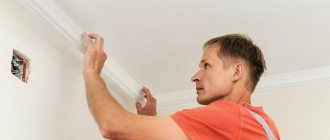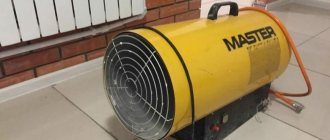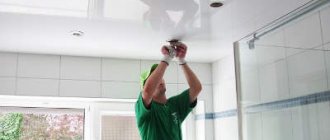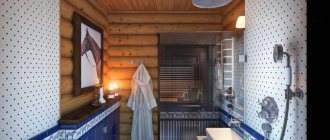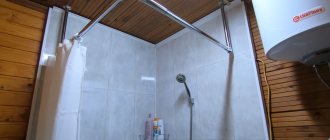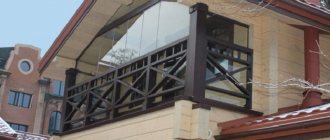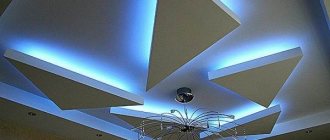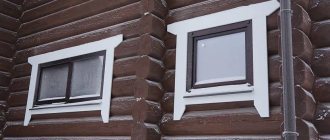In city apartments and office premises, stretch ceilings look quite familiar. This finishing material has gained great popularity due to its ease of installation and richness of colors. Such properties allow you to realize the most daring design solutions. Stretch ceilings in a private house built of wood began to be installed relatively recently. This is explained by the operational features of such buildings.
Is it possible to make suspended ceilings in a wooden house?
It is allowed to install tensile structures in wooden houses, but when performing the work it is important to observe the subtleties of the technological process. Installation is no different from installation in a city apartment. The difficulty lies in the operating features of a structure made of wood.
You should not install a suspended ceiling in a recently built wooden house. Over time, as a result of shrinkage, the geometric dimensions of wall and ceiling ceilings will change and waves will form on the panel.
You can begin finishing the ceiling only 1.5-2 years after completion of construction.
Materials made from polyvinyl chloride film are subject to cracking when exposed to negative temperatures, so PVC sheets cannot be installed in unheated buildings.
The harmful effects of dampness on fabric ceilings lead to the destruction of their color and loss of aesthetic appearance. In addition, the material that has absorbed moisture quickly becomes moldy, so such finishing is not recommended in unfinished log houses and unheated wooden buildings. When installing suspended ceilings, you should understand their pros and cons. Let's look at the main advantages and disadvantages.
If the roof is leaking
If the roof covering is damaged, rain and melted snow will collect on the inner surface of the stretch ceiling, from where the liquid can be collected in a separate container. To do this, the repair team unfastens the edge of the structure, drains the water, dries the canvas and pulls it back.
Important! It is natural for a tree to draw water onto itself. Therefore, drying takes longer. If you stretch the ceiling under a damp attic or interfloor ceiling, then the appearance of mold is inevitable.
Film ceilings can retain liquid for several days without losing their properties, fabric ceilings can hold liquid for 2-3 hours and immediately become unusable. Paint designs on canvas made of polyester threads may blur even if over-moistened.
The presence of ventilation grilles violates the tightness of the structure. In order not to lose the valuable property of PVC ceilings to retain water, it is worth considering other air exchange options.
Pros and cons of this solution
Positive qualities include the following:
- simplicity and speed of work;
- no need to level the ceiling surface;
- protection of the renovated room from water leaks from above;
- ease of care of the coating;
- incredible variety of colors and textures;
- masking ceiling defects and the ability to hide communications.
Well-installed tension coverings, with proper care, will serve their owners for more than 15 years without loss of performance characteristics. The perfectly smooth surface retains the brightness of the colors and does not sag or crack over time.
The disadvantages include:
- the possibility of surface deformation in an unheated room;
- the risk of accumulation of condensed moisture vapor, mold and infection of ceiling beams by pathogenic microflora;
- slight vibrations of the material when a draft appears;
- cuts from sharp objects make it impossible to repair the finish;
- Rodents can live in the space between the ceiling and the tension fabric.
By following the rules of operation and installation, you can avoid the manifestation of most negative qualities. This circumstance is confirmed by practical experience in the use of tensile structures by owners of log houses.
Ceiling shape
The design of ceilings provides a wide variety of designs: simple, classic, complex, futuristic.
The interior design is usually chosen by the owner, according to his taste and imagination. But you can seek help from a specialist who will advise the best design solutions.
In wooden houses, due to the plasticity of materials, suspended ceiling designs are possible:
- Single-level canvas covering the entire area of the room.
- Stretch ceiling divided by beams.
- Multi-level configurations, divided into small sections and zones.
- Caisson.
- Arched tension structures.
- "Starry Sky".
- With built-in stained glass windows.
- Complex shapes.
Choice of fabric depending on temperature conditions
The canvas for suspended ceilings is made of polyvinyl chloride film or synthetic fabric. The choice of material largely depends on the temperature conditions at which it will be operated.
PVC film is subject to thermal expansion and contraction, this circumstance negatively affects its performance characteristics. In addition, if the temperature drops sharply, the stretched fabric may crack to the point of being unusable. As a result, further use will be impossible and the material will have to be completely changed.
The operating temperature of PVC sheets ranges from +5 to +50°C. As a result, it is advisable to use polyvinyl chloride film for arranging a stretch ceiling only in year-round heated buildings.
Owners of country houses with seasonal residence should prefer fabric. It is significantly less susceptible to thermal expansion and can be operated without loss of performance characteristics at temperature fluctuations from -50 to +40°C. Therefore, only fabric stretch ceilings can be installed in a country house or village house.
When installing PVC film with your own hands, it is important to consider that the material requires heating to 70°C. To do this, you need a heat gun, which in inexperienced hands can damage the wooden ceiling. There is no need to heat the fabric ceiling during installation; it is easier to install it yourself.
Installation of tension structures for stove heating at home
The presence of a stove does not interfere with the installation of modern ceilings. The main thing is to prevent overheating of the canvas and baguette. To do this, you can do the following:
- install a plasterboard box at a distance from the chimney;
- secure the mortgage, which acts as a layer between the baguette and the chimney.
If the stove is large and is heated red-hot, it is better to play it safe and secure the canvas at a distance from the heat source, covering the remaining space with boards.
Keep in mind that in a house with stove heating, the coating will have to be washed more than once or twice a year. But, unlike other finishing materials, stretch ceilings are easily cleaned of soot with detergents and a damp sponge. Do not use abrasive or aggressive substances for cleaning. They may leave scratches or dissolve the material.
How to make a suspended ceiling yourself
First of all, it is necessary to take into account the functional purpose of the room in which the tension fabric will be used and prepare it correctly. There are nuances to performing the work if the building is built of timber or has stove heating. The technology for installing a tension structure on a ceiling with beams is also slightly different. In addition, it will be necessary to solve the problem of condensed moisture vapor, which has a destructive effect on wooden floor beams. Let's look at each situation in more detail.
Features of preparation
In general, the preparatory stage includes the following actions:
- Check the integrity and, if necessary, repair roof leaks. Atmospheric moisture that has leaked through the roof will not break through the stretched fabric, but will require regular removal of water and drying of the material.
- Treating the rough ceiling with agents that prevent the development of pathogenic microflora and fire retardants that prevent fire. After installation is completed, these manipulations will not be possible.
- Extermination of rodents and insects. Otherwise, mice, cockroaches, ants and other living creatures will settle in the space between the panel and the ceiling. To do this, you should also cover all cavities.
- Arrangement of high-quality ventilation to prevent wood rotting and mold formation, since the stretched fabric prevents the free movement of air masses.
- Drawing up a diagram of the location of lamps and laying electrical wiring.
If the house is made of timber
Installing suspended ceilings in a timber house requires highly qualified performers of this work. If the building is made of profiled timber, there will be no problems. The installation difficulties lie in the difficulty of attaching a flat profile to the rounded surface of a rounded log.
If you fix the baguette in the middle of the beam, then on the other side at this level there will be a joint of the logs. In addition, you will need to cut the profile at a complex angle and glue the joints. To facilitate this work, a flat base of lumber, such as boards or OSB, is constructed around the perimeter of the room. The resulting gap will be closed by installing a wooden ceiling plinth.
If the house has a stove
If there is a stove in a log house, you will need to do the following:
- Place a plasterboard box around the chimney. The air gap between the chimney and the gypsum board will protect the tension fabric from overheating and melting. Additionally, you can use a coaxial chimney. It has a double pipe design and produces less heat.
- Install a mortgage to securely fix the profile to the drywall. A block is screwed onto the inside of the gypsum plasterboard box, to which a baguette for the stretch ceiling is subsequently attached. If this is not done, when the canvas is tensioned, the profile will tear out of the plasterboard, since the fragile gypsum structure of the material is not designed for such loads.
The operation of the stove is associated with the formation of smoke and soot, so the ceiling will have to be washed more often. Contaminants are easily removed from the surface of the stretched film with mild detergents dissolved in water. Do not use aggressive compounds, including abrasive particles and acids, for cleaning, as they can seriously damage the coating.
Solving condensation problems
To prevent the negative effects of moisture, the wood is impregnated with compounds that prevent the formation of mold and mildew. Since PVC film does not allow air to pass through, natural or forced ventilation is installed. Grates are installed in diagonally opposite corners to reduce the pressure difference and thus prevent the accumulation of vapors. Additionally, it is recommended to install a ceiling exhaust fan.
In rooms with high humidity levels, in the kitchen or bathroom, installing film ceilings has positive aspects. Moisture will be deposited on the surface of the canvas without penetrating the wood structure.
Solving condensation problems
Even if all the necessary technologies are followed, during installation between the ceiling and the coating, conditions often arise for the formation of condensation.
The accumulation of moisture is caused by the fact that the film does not allow air to pass through. The tightness of the structure does not allow the liquid to evaporate naturally. With a fabric covering, condensation is less likely to form. However, even when using this material, the risk of moisture accumulation remains.
To protect the house from fungus and mold, wooden fragments must be treated with a special compound before installation of the canvas. If the installation of the coating is planned before the start of construction, it is necessary to treat the wood after the construction work is completed.
It is advisable to install ventilation grilles on the canvas. They are placed at the edges diagonally from each other. Installation of grilles is carried out according to the same rules as the installation of lighting fixtures. If ventilation is installed next to the lighting, it becomes almost invisible.
When choosing a coating, it is necessary to take into account the humidity of the room in which it will be installed. It is advisable to install PVC film in the kitchen and bathroom. In this case, the tree will be protected from internal influences. The rising steam will settle on the film without penetrating the wood.
Installation technology
The main stages of installing a stretch ceiling:
- Cleaning walls and ceilings from dirt, treating surfaces with protective agents.
- Determining the location of lighting fixtures, installing mortgages and supplying electrical wiring.
- Marking and fastening profiles at a distance of about 10 cm from the rough ceiling. The baguette is screwed with 6x50 wood screws or universal galvanized screws with a pitch of 10-15 cm.
- Warming up the room with a heat gun and tensioning the fabric. The film is tucked into the baguette starting from the corners and gradually moving towards the center. Fabric ceilings do not require heating and are stretched from the middle of the walls to the corners; upon completion of the work, the remaining fabric is cut off with a knife.
- Installation of lighting fixtures. In places where spotlights are installed, special thermal rings are glued to the canvas, protecting the film from tearing and overheating. Next, a hole is cut inside the tread ring and a lighting fixture is attached to the insert.
- Sealing of butt joints. The places where the baguettes adhere to the wall are covered with decorative tape, masking the installation joints.
Features of installation in a house with beams
If the design project provides for the external location of the beams, the installation of the tension fabric has some features. There are two ways to make wooden beams on the outside of the finish:
- The canvas is stretched over pre-installed base beams. Decorative false beams are installed on top.
- The stretch ceiling material is fixed in the spaces between the beams. To do this, it is divided into fragments of the required configuration.
It is much easier to do the work using the first method, but if the ceilings are low, it is not recommended to use it, since the usable area of the space is reduced. The second method is more complicated to implement, but can be used in any room.
Roof leakage
If, due to a roof leak, moisture has accumulated under the roof sheet, it is necessary to immediately invite a team of workers. The edge of the stretch ceiling is unfastened and the liquid is removed. The wood must dry out within a few days as some of the liquid has been absorbed into the wood. Then the disconnected edge is fixed in its original place.
If you are confident in your abilities, you can drain the water from the stretch ceiling yourself.
When roof leaks occur in a home with a fabric ceiling, the covering will need to be replaced. Fabric sheets become unusable within 3-4 hours after exposure to a large amount of moisture. Film coatings can retain water for several days.
What to consider during the construction phase
When planning the installation of tensile structures in a wooden house, it is recommended to provide for all the nuances of subsequent operation during the construction stage:
- The height of the ceilings is selected taking into account the characteristics of the decorative coating.
- Roof waterproofing work is carefully carried out to prevent the infiltration of atmospheric moisture.
- To avoid the appearance of fungus and mold, ventilation is provided. Additionally, the wood is impregnated with compounds that prevent the development of pathogenic microflora and fire.
- To prevent rodents from settling in, cracks in the sub-ceiling are carefully sealed and devices are installed to repel them.
- Measures are taken to prevent construction dirt from falling off the rough floor, otherwise, after the film is tensioned, debris will fall onto the canvas. To remove it, you will have to dismantle the ceiling.
- At the construction stage, a thermal frame is immediately installed around the chimney pipes from the fireplace or stove.
In conclusion, it can be noted that stretch ceilings, which have recently appeared on the modern construction market, are gaining increasing popularity as a finishing material. The advantage is determined by the high performance qualities of the decorative coating, its long service life, resistance to moisture and ease of surface care. Like any building material, tensile structures have pros and cons, but the advantages far outweigh the disadvantages.
Features of preparation
In a private house, you need to pay attention to the materials used to decorate the wooden walls. If they are covered with plasterboard or clapboard, then fastening the frame under the film will be easily installed.
A rounded beam, on the contrary, will complicate the work of the master.
Some people insulate the top floor. This reduces temperature changes, which can negatively affect the condition of the canvas: it can sag in the heat or crack in severe frosts. If there are leaks, the roof is repaired.
It is necessary to check how the wiring is installed. Overheating of the cable or wires in the immediate vicinity of the fabric can deform it or cause a fire.
Depending on the height of the ceiling, the type of construction is chosen. It doesn’t make much difference which profile will be used, but the plastic one is more elastic: it can adapt to the curves of the wooden wall cladding.
If the house is completely new, they wait two years until the foundation settles.
Examples of suspended ceilings in the interior of a wooden house
Assembly
The room is measured and the material is secured using a profile. Then they connect to the base corner and beams, after which they move to the opposite corner, continuing the fastening. The frame is installed and fixed in a baguette. The fabric is slowly stretched, fixing the corners.
If the house is made of timber
Wood is by no means a simple material. In houses built from timber, suspended ceilings are practically not installed. This is a very difficult job that requires the skills and dexterity of the one who takes on this matter. In this case, you should pay attention to the following recommendations:
It is necessary to install a ventilation duct, since false ceilings do not allow the wood to breathe. It is for this reason that mold forms and fungi appear.
The film is stretched using a heat gun, but fire should be avoided.
Positive properties and disadvantages of film ceilings
Film stretch ceiling is a special material. The basis for creating such a film is polyvinyl chloride. It stretches when heated. The work is carried out using special equipment - a heat gun. A house decorated with this material takes on a beautiful appearance.
PVC stretch fabric
Advantages:
- matte or glossy, even and smooth finish;
- no cracks;
- durability;
- in case of leaks, withstands large amounts of water;
- no painting required;
- easy care.
Flaws:
- the canvas does not breathe;
- installation requires special equipment;
- It is easy to damage the film with a sharp object.
Selection of bars for wooden sheathing
To create the ceiling sheathing, you will first need wooden blocks. In this case, you can choose any type of wood. The main thing is that the material itself is dry (humidity should not exceed 18-20%).
The size of the bars is selected based on the formed size of the inter-ceiling space, since the design of the suspended ceiling provides the possibility of laying heat-insulating boards or laying communications. But, as a rule, to create a wooden sheathing it is enough to use slats with a cross-section from 20*40 to 80*40 mm. Although you can choose any other size, the main thing is that the height of all bars is the same.
Multi-level structures
Nowadays you won’t surprise anyone with multi-level ceiling structures. A wooden house is no exception. Previously, such compositions were assembled using only drywall. But today combined designs have become popular.
Multi-level plasterboard ceiling
What materials and technologies to use depend on the allocated budget for repairs. After all, the materials differ significantly in price. You can make a slatted structure that will be framed by drywall.
Rack design
Material such as drywall has not lost its relevance. It is used for suspended structures and perfectly complements the tension fabric. In this case, opportunities open up for implementing the most daring decisions in interior design.
Type of plasterboard construction in the interior
In combined designs with plasterboard, different colors and textures are used. PVC film or fabric is placed on 2-3 levels, creating interesting combinations. The main thing is that they complement each other and match other elements of the interior.
Combined ceiling
Typically, drywall is used to make one tier, and the second is a stretched canvas. This is a good option when a wooden house has low ceilings, but there is a desire to make them visually higher.
An excellent solution to make a wooden house seem taller is to use several colors. It’s good when the drywall is matte around the edges and glossy in the center.
Drywall and PVC sheet
Drywall is also combined with textile covering. Due to the fact that the material is universal, many options are found for its use.
What is the difficulty?
Most types of such decorations are attached in two main ways: with glue or on special mounting platforms in the form of square or rectangular bars, fixed to the ceiling. Such parts are simply screwed to pre-installed platforms with self-tapping screws through the body. The choice of type of fastening depends on the weight of the structure - if the beam is made of polyurethane, and therefore very light, good glue will be enough. For heavier structures, self-tapping screws are used.
However, nothing can be screwed or glued to thin stretched fabric or PVC film - the fabric simply will not withstand even the small weight of polyurethane parts and will inevitably sag, if not break at all. Therefore, when installing a ceiling of this type, it is necessary to immediately provide for embedded structures, to which you can subsequently screw whatever your heart desires.
But it is not always possible to have such an opportunity or the desire to decorate the interior with such a beautiful detail arises after the ceiling has been stretched. In such a situation, it would seem that there is no way out, but there are still options for installing such decorative elements. They will be discussed in the next section.
Recommendations for choosing tension fabric
If the decision to install a stretch ceiling has been made, you should seriously think about what role the canvas will play in the overall design solution of the room.
First of all, you need to decide which ceiling to choose - gloss or matte surface. It should be noted that matte stretch ceiling is a universal solution for any interior. However, according to reviews from designers, the glossy version can serve small rooms well - visually expand the room, adding height with the help of reflection.
The color of the ceiling can also play a significant role in playing out the space. For example, in order to create more space, you need to choose light shades of turquoise, light green options, as well as classic white.
According to designers, for special interiors in which the atmosphere is thought out to the smallest detail, dark tones, black, chocolate and blue may be suitable. Warm colors will help create coziness and add joyful shades where the windows face north.
With the development of new technologies, stretch ceilings have become decorative and can become the center of a composition if photo printing technology is used. It allows you to place any patterns, paintings, frescoes, etc. on the ceiling, which gives a lot of scope for design ideas.
